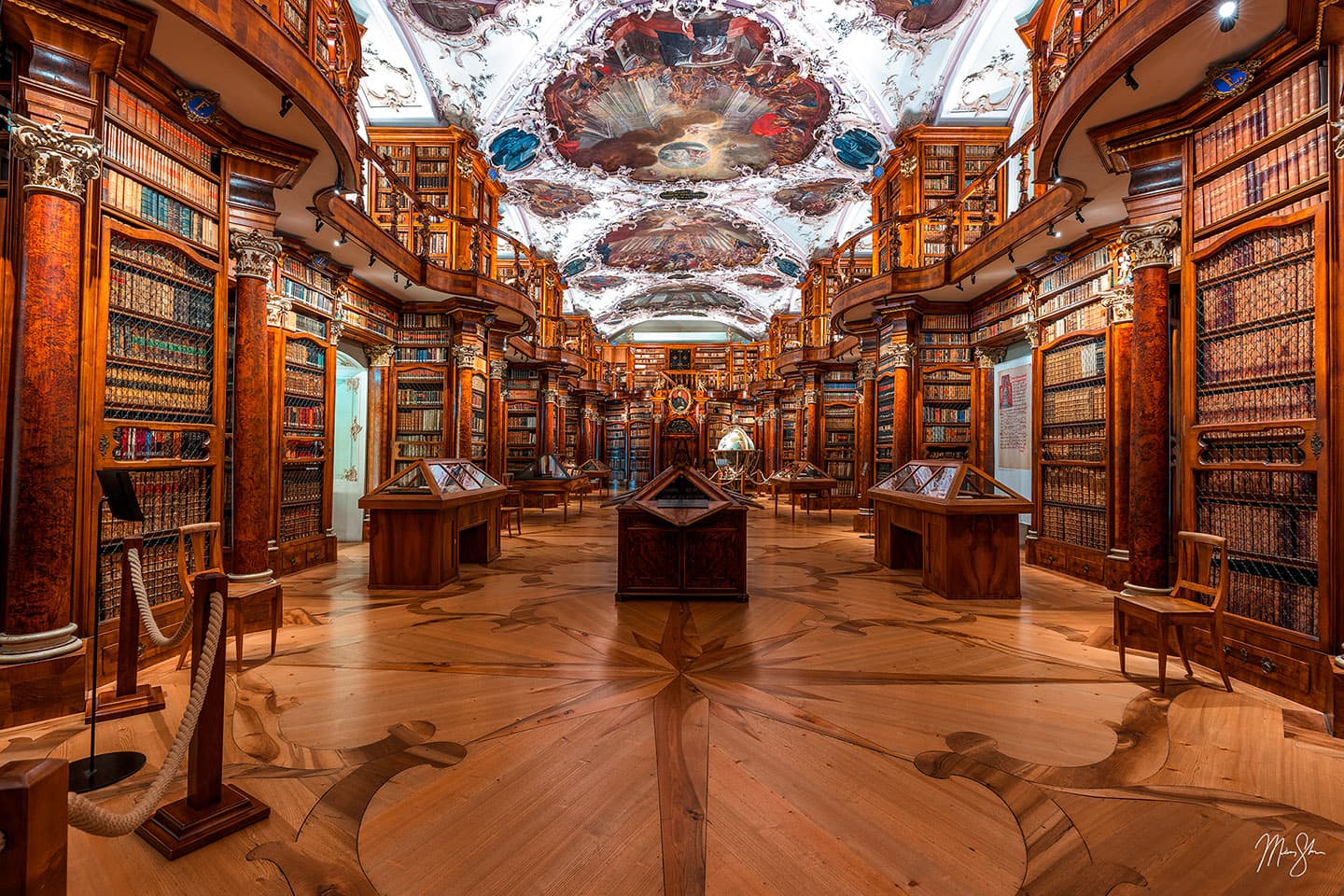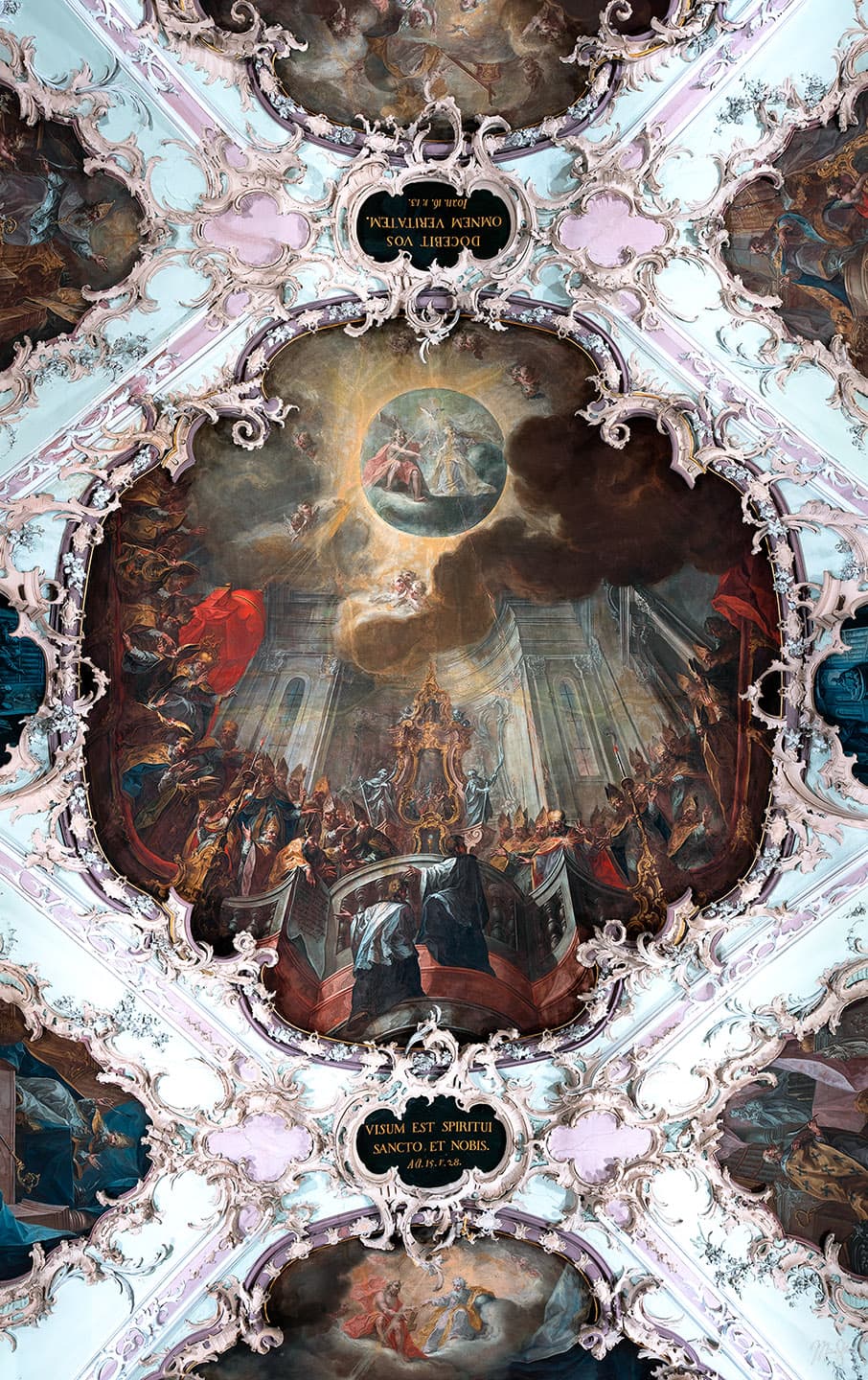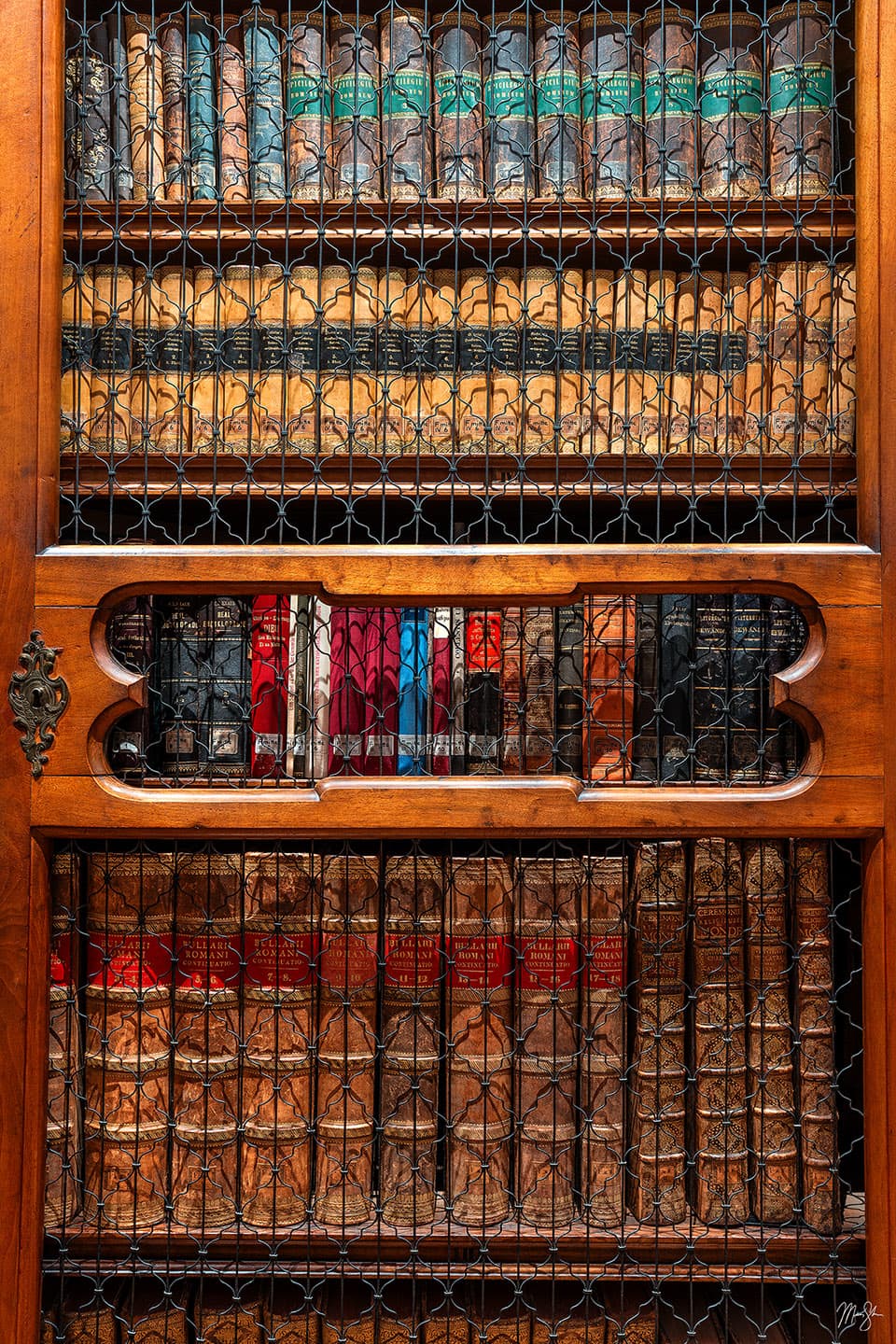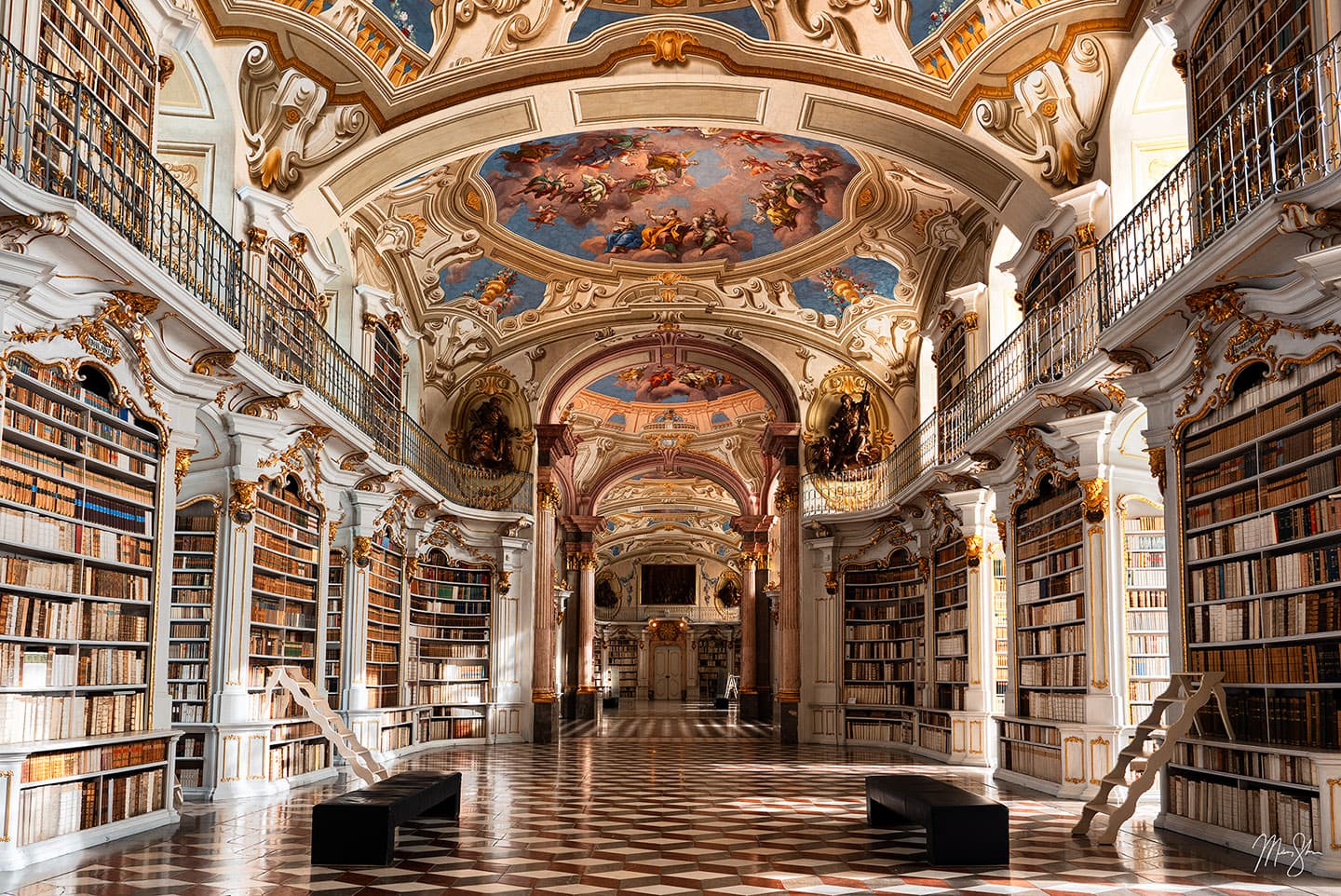There are very few places in the world where time feels as though it has truly stopped. Walking into the St. Gallen Abbey Library is one of them. Even before actually walking into the library, you already know you are in for something special. Before I could take a step into the library, I was asked to remove my shoes and put on special slippers to walk in. You see, it’s made from walnut wood and includes patterns like four large stars and other elements that have been there since the 18th century. Even my tripod needed it’s own three slippers to keep from damaging the beautiful flooring.
Photographing this beautiful library was unlike anything I’ve experienced. I was fortunate to be granted a private, early morning access, before the doors opened to the public. Besides the wooden flooring, when I walked in, I was stunning by the ornate wooden bookshelves curved gracefully along the walls. Carved cherubs and ceiling frescoes were a visual treat in all directions.
Having visited the Admont Abbey Library in Austria the day before, I was curious how Switzerland’s St. Gallen Abbey Library would compare to it. If the Admont Abbey Library was a cathedral of bright, airy and ethereal light, then St. Gallen Abbey Library felt more like a sanctuary of wisdom and warmth, owing to its detailed beauty. While walking through Admont invited me to look up and marvel at the open hall, St. Gallen drew me in to linger and want to leaf through ancient volumes and yourself in the quiet richness of centuries of thought contained in the leather bound volumes on its wooden shelves.

View More: Beautiful Libraries of the World collection
Over a Thousand Years of History Inside Switzerland’s Oldest Library
The Abbey Library of Saint Gall (German: Stiftsbibliothek St. Gallen) dates clear back to the 8th century. Considered one of the oldest library’s in Switzerland, and the world for that matter, still in continuous use. It is housed within the historic Benedictine Abbey of Saint Gall, having been a house of knowledge and learning for over 1,2000 years.
Constructed by architect Peter Thumb in the mid-1700s, the current Baroque library hall is a masterpiece of Rococo elegance. The ceilings are adorned with frescoes by Josef Wannenmacher and depict allegories of science and religion. Looking up, you are greeted by ornate frescoes that depict the four major councils in Christian church history: Nicaea (325), Constantinople (381), Ephesus (431), and Chalcedon (451). In retrospect, I wish I would have photographed all of the frescoes while I was in there, but only photographed the Council of Ephesus fresco, pictured below. Between these four grand frescoes of the councils are representations of the historical Church Fathers and are enveloped by angels and scrolls designed by the Gigl brothers in 1761. These ceiling frescoes really set the tone for the entire library.

On the walls, intricately carved bookcases house more than 170,000 volumes. The library houses early medieval manuscripts and priceless codices, including the Irish Gospels of St. Gall (also known as Codex Sangallensis 51 or MS 51) which are amongst the oldest Latin Gospel manuscripts in the Western world. In addition, the library’s collection of Carolingian-era texts from the likes of Augustine, Ambrose, Gregory the Great, and Isidore of Seville are considered one of the most important in the world.
An Architectural and Cultural Treasure
The library was designated as a UNESCO World Heritage Site in 1983. The Abbey and its library aren’t just significant for vast historical archives, but for the inclusion of European Baroque architecture and Enlightenment-era ideals woven into the fabric of the walls. As I mentioned above, visitors are required to wear protective slippers to preserve the pristine wooden floors, which is just a small gesture that adds to the timeless atmosphere of the space and makes you feel a certain reverence for the place and all it holds within its walls.
It comes without saying that this is one of the most beautiful libraries in the world. From the craftsmanship of the balustrades to the soft palette of pastel tones, every single detail contributes to an environment that feels more like a sanctuary than a study hall. As a photographer, I could have spent all day photographing these library walls and architecture. As a Christian and someone with interests in history, I could spent far more time just looking through the volumes of books on these walls. Having learned the day before that the second floor of Admont Abbey’s library was off limits to all but the “paters” (Fathers or priests), I was hesitant to ask, but I thought it was worth trying. I asked if I could go to the second floor to take one more photograph and was told I could! Walking up the old wooden, spiral staircase to the second floor was an experience in itself. While some of the lighting was a bit difficult, I managed to pull of the shot below from the second floor balcony, looking down from the opposite side as I photographed looking up on the floor.
While up there, we had a conversation about the beautiful world globe on the floor below. As a lover of maps, and clearly of travel in general, that was one of the first things I took note of when entering the library. I found out that the original was actually stolen. First created by Vincenzo Coronelli, a Venetian cosmographer and cartographer known for creating some of the most advanced globes of the times, it was taken after the looting of the St. Gallen abbey in the 1700s during the second Villmerger War to Zurich where it remains to this day. Long story short, it was only in 2006 that this dispute ended. After over 7,000 hours or work, with a cost of around a million Swiss francs, a replica was delivered to the library in 2009.
One other treasure in the library that caught my attention were two intricately carved wooden sarcophagi. These contained the 2,700-year-old mummy of Shep‑en‑Isis, thought to be the daughter of a Theban priest who lived around 650 BCE during Egypt’s 26th Dynasty. They add a touch of antiquity and are some of the most visually striking artifacts in the library.

The “Beautiful Libraries of the World” Collection
Hopefully you enjoyed reading a bit about the St. Gallen Abbey Library and my time photographing it. My photos from St. Gallen are now part of my Beautiful Libraries of the World collection of fine art prints. This is an ongoing collection I created that celebrates the visual beauty and historic richness of the world’s most iconic libraries. For those who love old books, historical architecture, or simply beautiful interior spaces, this library is a must-see in person and hopefully just as inspiring to experience as a fine art print!
Location copyright is to the St. Gallen Abbey. Special thanks to St. Gallen Abbey and their staff for graciously hosting me and allowing me to capture these images for my Beautiful Libraries collection.
